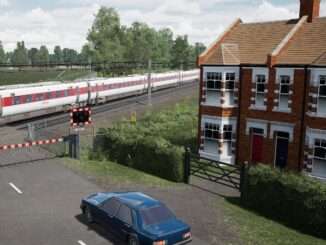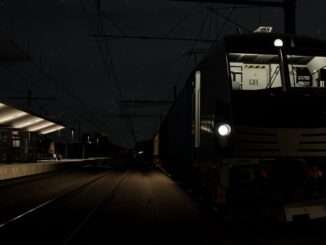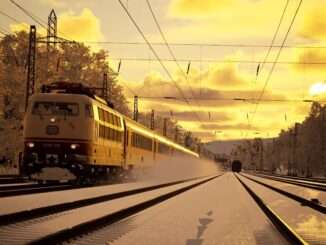
Essential to driving trains, is information. In reality, that information comes from knowledge, experience and the train cab, and you can achieve all of those here, but to help you along the way, enter the Heads Up Display.
The Hud & Ease of Access
There are multiple HUD options to choose from, from overall style to what info is displayed and where, all to perfectly cater to your driving. Once you are proficient enough, maybe you could ditch the HUD altogether for the ultimate experience. But for now, let’s go over the different HUD options in Train Sim World 4. Please note the HUDs shown here are compressed for ease of viewing
Normal Hud

- This top left bar provides the current time, as well as time, distance and details of your next instruction.
- This is the Action Points bar, which shows the total accruement of points throughout a service, this can be toggled on and off on any HUD.
- These right-hand side bars can show the details of the next signal, speed limits and their distances, these can be toggled on and off on any HUD.
- This is the steam pressure gauges, so only shows for steam locomotives, the top gauge is boiler pressure, the lower is cylinder pressure, you can also see airflow from the blower and dampers on the left.
- These symbols are floating versions of the stop, signal and speed limit markers which point to where they are within the world, these can be toggled on and off on any HUD.
- This is the speedometer and brake gauges, where you can find your actual speed vs the speed limit, the status of different brake systems, how much power you’re applying, whether the doors are open or not, the gradient, and more (including signalling systems and cruise control on different trains).
Simple Hud

- This top left bar provides the current time, as well as time, distance and details of your next instruction.
- This is the Action Points bar, which shows the total accurment of points throughout a service, this can be toggled on and off on any HUD.
- These right-hand side bars can show the details of the next signal, speed limits and their distances, these can be toggled on and off on any HUD.
- The speedometer in the Simple HUD does away with the side bar brake and gradient information, reducing the amount of input to focus on the essentials, although some of the removed detail can still be found in the train cab instruments.
Minimal Hud

- The top left bar now provides a slightly different set of information, the time is still there, but the distance to th next instruction has been replaced with a barber pole, this will count down visually and change colour as you approach the next instruction, or as you load passengers. Also now featuring in the bar is current speed and gradient information.
- This track monitor allows you to see the upcoming signals and speed limits for the next 2km or 1.25 miles, this helps to look ahead, and see speed reductions or quickly dropping signals with enough time to plan for them – this can be toggled on and off on any HUD.
Other Hud Info
The signal aspect uses a simple traffic light and bar system to represent the general state of the next signal, not directly relaying what an in-world signal might be saying, for example if a signal is a diverging aspect, or speed reduction, that information is only present on the actual signal itself. You can also toggle to keep the distance to the next signal, while hiding the aspect entirely, this means you must rely on seeing the signals out of the windscreen to follow them appropriately.

Lastly, you can toggle how certain information can be displayed. You can choose to leave everything on their automatic settings, or force the HUD to use imperial or metric measurements as you choose.
Ease of access
Depending on your preference, and set by various defaults when creating or importing a profile, there are a handful of additional settings which can help alter the experience to your liking.
Automatic junctions
There are generally 2 types of junctions on routes, automatic and manual. Automatic junctions are set by the dispatcher and are usually found on the mainline, protecting big junctions and stations. Manual junctions are most often found in yards and sidings, and have a lever or handle to physically operate in order to change the intended direction of travel.
In Train Sim World, when Automatic Junctions are enabled, this will auto-set manual junctions for you as well, meaning you do not have to get out of the cab and walk to junctions on foot, nor look on the map and try to navigate your way through a yard manually.
Automatic coupling
Much like junctions, there are multiple ways of trains coupling, in many modern trains, its a case of drawing up slowly to another train, pushing a button, and done, but in others, particularly where chains, buffers and knuckles are involved, the process is a lot more labouring; attaching the chain to the hook, dropping or unlocking the knuckle, all on-foot work.
In Train Sim World, when Automatic Coupling is enabled, you will be able to hand off the complexities and simply perform a coupling procedure by pressing a button when prompted.
The combination of automatic junctions and coupling makes procedures like shunting/switching a much more driver-focused experience, you can stay in the cab and worry about the train, without getting lost or constantly leaving the cab. Not only does this make it easier in many respects, but ut is also more realistic, as generally speaking, yard workers would be handling most of the tasks anyway.
Theese options can be toggled to your preference at any time.
Driver assists
If you’re attempting to do something in a train, and there’s a step you’ve missed, or something you’ve selected incorrectly, then driver assist pop-ups should advise you so you can correct whatever needs doing for you to continue.
I’m stuck
If you’re in a bit of a situation and just want to get out of it, be that stuck on brakes, or the train won’t take power, in the pause menu we have a Reset button – this will return the train to a default state so you can re-setup the train again, and get back on the move.
Remember, you can always come back to the Training Center to refresh your memory.





Be the first to comment